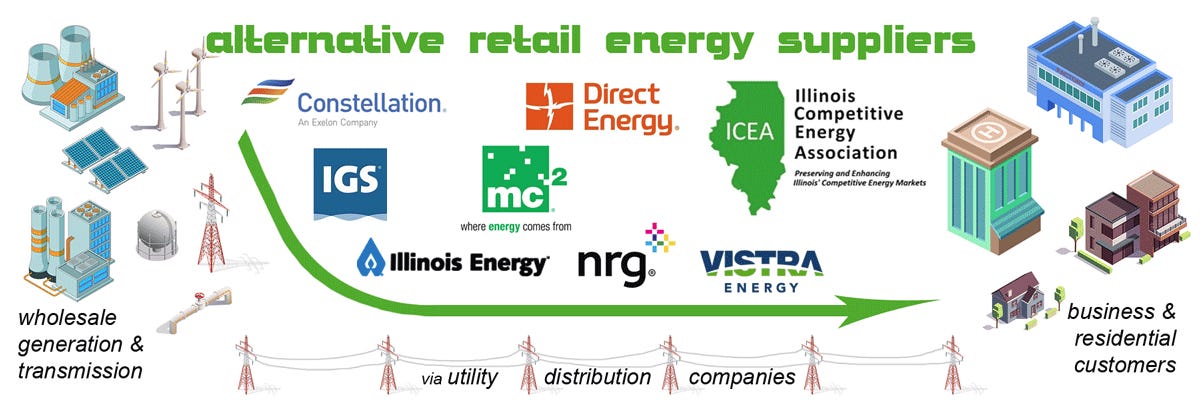Energy Deregulation: Fully-Fixed vs. Pass-Through Rates
A Short Guide to Maximizing Energy Savings with Deregulated Suppliers
Electricity is expensive. How can I reduce my costs?
Energy deregulation allows for extra market competition and cost reduction, allowing customers to choose their energy supplier and supply rate.
Despite the common misconception that ratepayers have only one product choice to receive their electric bill–a monthly variable supply rate with their local utility–they actually have more options than they may think.
What are my Deregulated Rate Options?
A wider range of fixed, variable, and block and index options are available through retail energy providers (REPs), which exist to expedite the supply process between utilities and consumers and provide competition to the market.
Through REPs, consumers aren’t subjected to their local utility’s monthly supply rate; instead, they can choose to have their energy supplied directly from a supplier for a lower rate. This switch results in no change to the customer, other than reducing their energy costs.
With the rise of energy demand encouraging alternative deregulated payment options in recent years, customers now have a range of ways to pay for the power to their homes and businesses. However, there is a wide range of supply rate options, and this variability can cause uncertainty over which payment plan will offer the most competitive rate.
Deregulated Costs
Of the three main charges in an electricity bill–the supply, delivery, and taxes and other fees–only the supply portion can be deregulated. The supply rate is calculated as a dollar per kilowatt-hour ($ / kWh) rate, in which accounts are charged by their electric usage per hour.
Supply Components
There are five main components of the electricity supply cost:
Energy – the cost of the electricity itself.
Capacity – the cost of electricity being stored, guaranteeing reliability during peak days.
Transmission – the cost of development and maintenance of transmission lines.
Ancillary Costs – the cost of other minor reliability fees.
Line Losses – the cost of expected electricity lost along transmission lines (a percentage of the energy cost).
What is my Best Payment Option?
While it is always possible to remain on utility supply, REPs offer other flexible plans for customers to take advantage of strong energy benefactors, seasonal weather, and optimistic forward curves.
Below is a list of suppliers’ popular rate products, along with their ideal customer profiles:
Fixed, All-In:
Locks in all five supply components for an extended period (commonly 1-3 years).
Reduces price volatility risk, with the supply rate remaining unchanged over the agreed-upon period.
Ideal for clients with lower usage (under 1,500 annual MWh) looking for guaranteed savings.
Fixed (Energy-Only) / Fixed (Capacity & Transmission Pass-Through):
Both products offer a similar plan, where only the supply rate's energy component (and sometimes the ancillary costs & line losses) is fixed, passing through the other components on a market index rate.
Ideal for clients with larger usage, who are willing to endure market fluctuations in an attempt to secure a lower rate.
Given the recent steep rising costs of capacity in multiple ISOs, which were motivated by a nationwide decline in operating power plants, customers may feel inclined to choose this option in a strategic bet that capacity prices may come down again in the future.
Fixed, All-In, 100% Green RECs:
In addition to the supplier’s fixed supplier rate, Renewable Energy Credits (RECs) ensure that the client’s electricity is sourced from renewable energy.
Popular options include adding either 50% or 100% Green RECs, with the chosen percentage determining the proportion of usage that will be supplied with clean energy
While Green RECs require a premium cost, this option allows clients the option to meet their net-zero goals.
Understanding your buildings' energy demands is a great way to identify the best pricing plan for your business. Listed below are other important factors that play a significant role in reducing energy costs:
Usage (kWh)
The amount of power (kW) used per hour – or the amount of electricity that an account uses when its devices are operating.
An account’s supply charge is calculated by multiplying its supply rate ($ / kWh) by its usage (kWh).
A lower usage will decrease your supply charge.
Capacity Peak Load Contribution (PLC)
The average demand (kW) of an account’s 4-5 peak hours in the summer.
A lower capacity PLC will typically decrease your supply rate.
Load Factor (%)
A measure of energy efficiency, which indicates an account’s usage consistency.
Calculated by dividing an account’s annual usage by its estimated yearly capacity PLC.
A higher load factor will typically decrease your supply rate.
Though the process of navigating choices of REPs, contract products, and supply rates may seem daunting, energy brokers are highly experienced in reducing supplier’s rates—and the added difficulty of selecting a provider.
By working with a trusted energy advisor, clients are granted insight into expediting their contracting process, maximizing their energy usage, and most importantly: saving money with cheaper supply rates.





You must be an engineer in one of us energy company 🤝💕